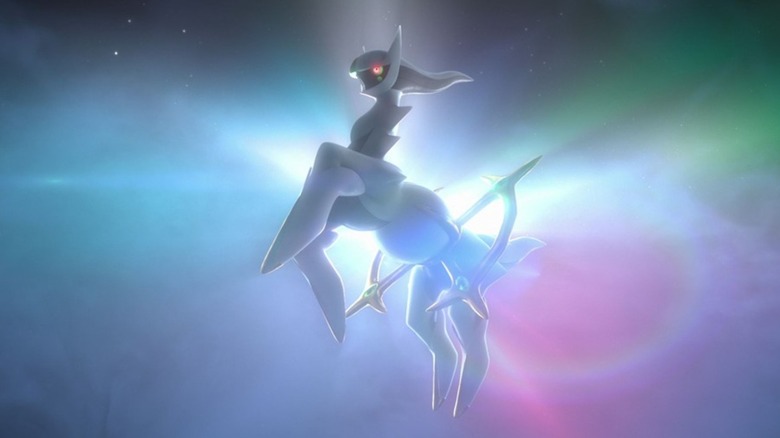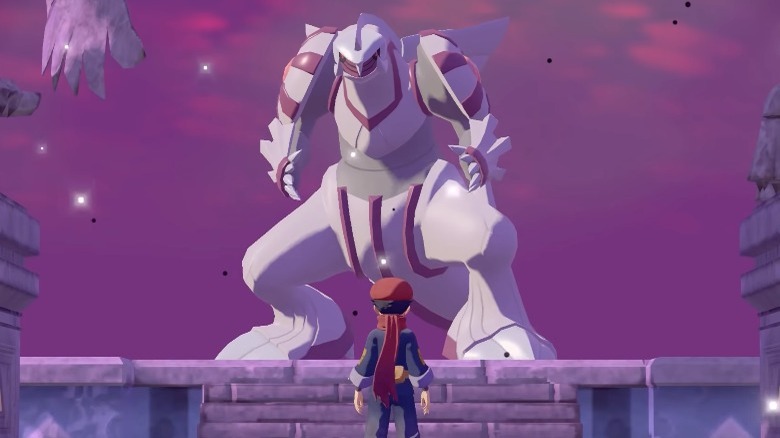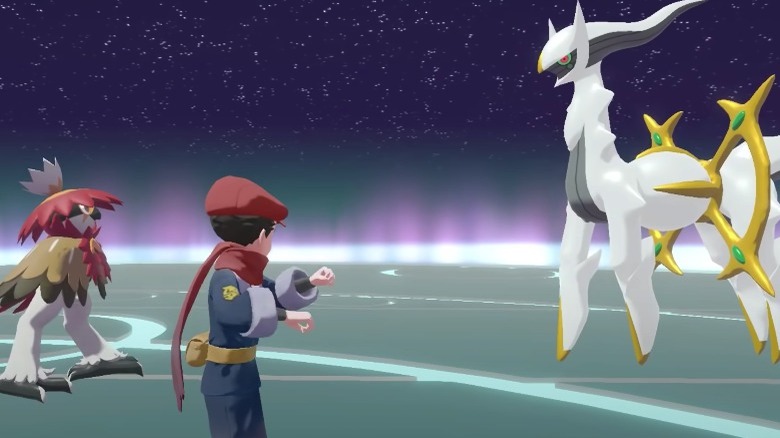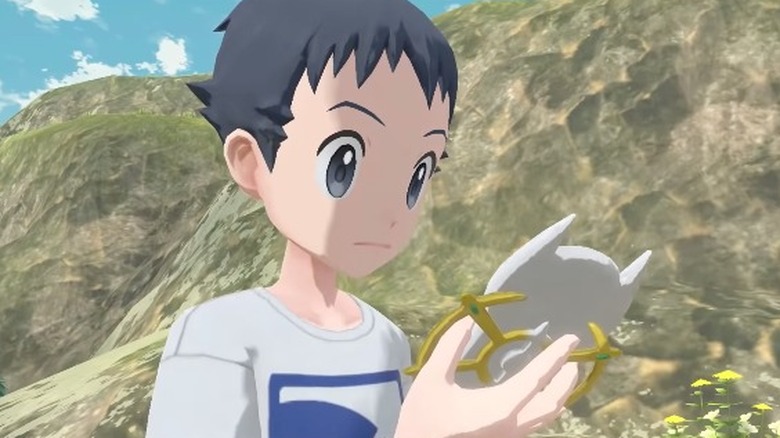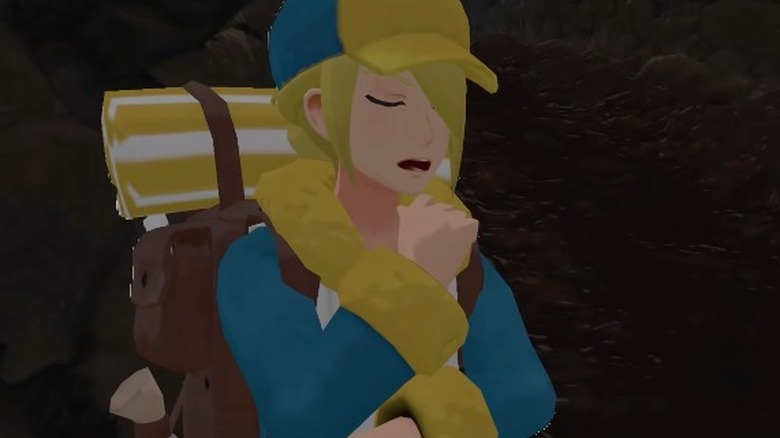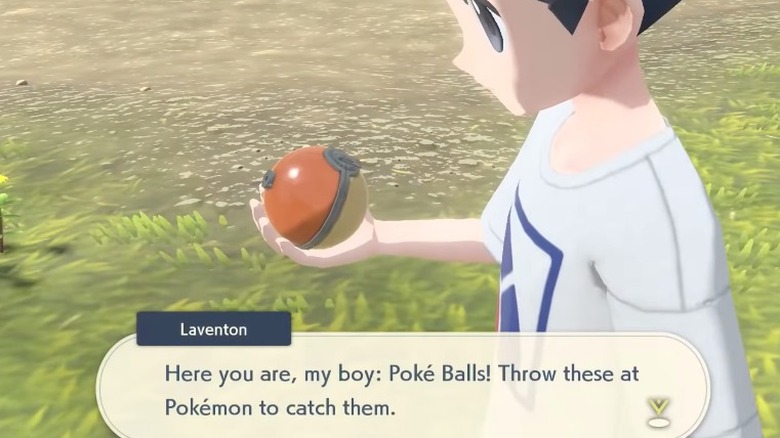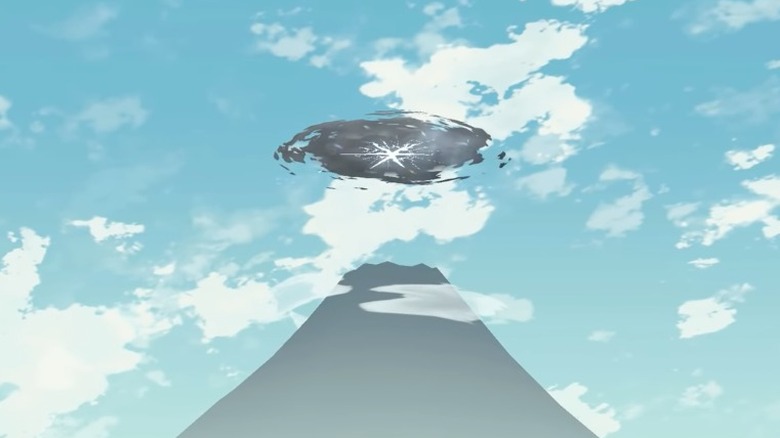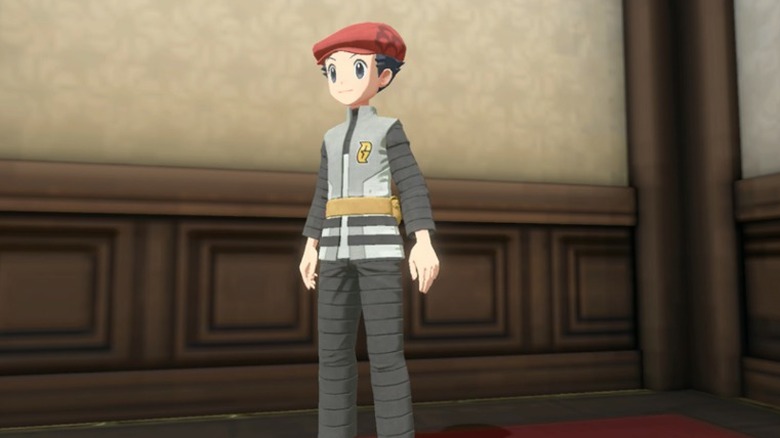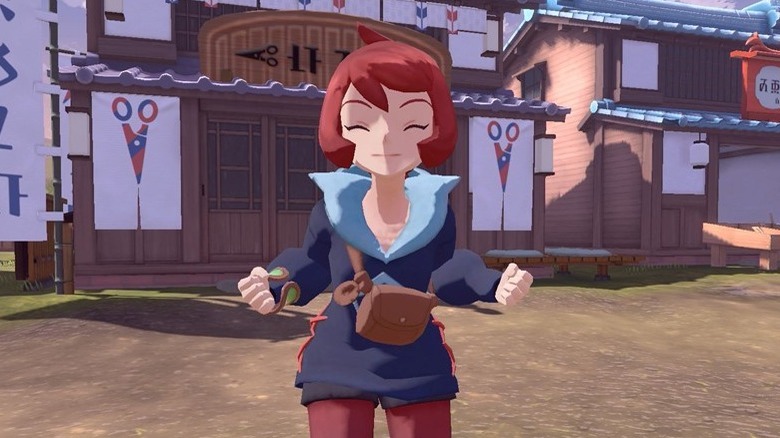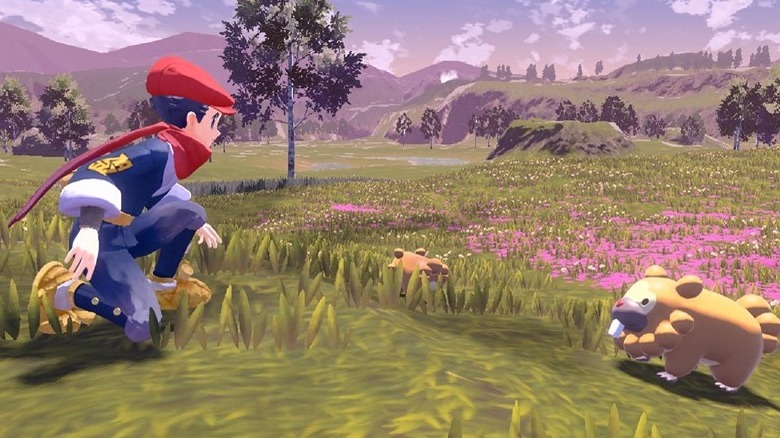Pokemon Legends: Arceus Ending Explained
"Pokemon Legends: Arceus" has arrived, bringing with it an entirely new style of gameplay for the franchise. However, the gaping space-time rift above Mt. Coronet didn't only drop gamers into a fresh experience with their beloved pocket monsters. It also put them into a previously unexplored moment in the history of the Pokeverse. If you have experience playing older generations like the "Diamond/Pearl" Saga, the ending of Arceus might seem like a linear building block in the chronology of the "Pokemon" canon. Yet, thanks to a multi-staged conclusion, the game's finishes leave a lot to be explored.
Previous iterations of Pokemon have sometimes built upon each other, and have other times felt entirely stand-alone. The tiered endings of Arceus land right in the middle by drawing direct connections between certain "Pokemon" regions, and also teasing potentially influential connections to others. As Den of Geek explained, the open-world format has flipped Game Freak's traditional formula on its head, all the while leaving players a sizeable amount of the post-game content they've come to love. Though we might not be hunting for Mewtwo, there is a lot to chase when it comes to the ending of "Pokemon Legends: Arceus." It's time to set out on our adventure.
Warning: Spoilers Ahead!
First Ending: Meeting the Legendaries
Throughout the main hunk of storyline gameplay, our character's mission is to quell Hisui's Noble Pokemon from the frenzied condition they've fallen into. However, the Nobles aren't the only Pokemon in an enraged state. We next find ourselves high above the Hisui region battling one of two Legendary Pokemon. There's a Red Chain involved, and we're starting to feel like we've been here before.
This time, there's a new twist to battling the Legendaries of Time and Space. Players will have crafted a previously unseen Origin Ball to catch the origin form of either Palkia or Dialga. With a 100% success rate for catching a godly strong Pokemon, you've got to wonder if the red origin ore used to construct this ball has anything to do with the dark-pink nodes on the future's Master Ball.
Both Palkia and Dialga have been caught and quelled, so the game surely must be coming to an end, right? Wrong. The sky may have returned to normal but the repercussions of the battle at Spear Pillar remain — all while Arceus, the architect of it all, remains to be seen.
Ending Two: Defeating Giratina
Arceus is still concealed, and the second ending reveals that the Creator Pokemon isn't the only one who's been hiding. Shortly after catching Dialga and Palkia, the coincidentally always-present Volo appears and goads our character into one last set of missions. Obtain 18 ancient Elemental Plates, he says. It'll be fun, he says. After an easy task involving more Legendaries, we meet Volo on top of Mt. Coronet. Turns out he's got the final Plate, and a mission that sounds familiar to any "Diamond/Pearl" players It's time for a fight to stop the newly revealed villain from reshaping the world.
The battle with Volo is the hardest trainer fight players will go through in Hisui. Defeating him doesn't end the onslaught, either. Instead, things get even more difficult after he summons Giratina. Giratina's two stages will test your battling skills more than any other challenge in Arceus, and the difficult fight is reminiscent of tough battles against Pokemon Champions of past generations. Once defeated by the player, Giratina flees to Turnback Cave, where capturing the Distortion Pokemon eventually becomes a new mission in itself. Volo, on the other hand, promises to find Arceus even if it takes generations. His comments are especially noteworthy considering who his descendants are.
Final Ending: Gotta' Catch em' All
With the real villain on the lam and their agent of destruction having placed itself in a position to be captured, it's reasonable to expect that the game has finally come to an end. Giratina has even turned a new leaf. Players will have finally gotten the Azure Flute, which is the ticket to meeting Arceus. So, naturally, that's got to be the ending. You step up to the edge of the temple, smash the A button with satisfaction, and... nothing!
Play the instrument all you'd like, but until the game's last quest is checked off, it is for an audience of one. Arceus can only be summoned when the final main mission is complete. This final quest will unlock the game's true ending, and it can only be accessed after you've found every pocket monster on the continent. Fortunately, features such as trade evolutions have been removed from the newest iteration of Pokemon. This makes Pokedex completion a much more surmountable task and allows a true ending to be well within reach. It also proves that the final event has returned the Pokemon franchise to where it started.
Back to Basics
"As Pokemon Legends: Arceus" was prepping for release, there were a lot of comparisons to "The Legend of Zelda: Breath of the Wild" (per Vox). However, there is another "Zelda" game that can also be tied to Arceus.
Like "Skyward Sword," "Legends" takes the storyline of an established universe back to the furthest point in time. In doing so, it returns players to the original mission of the series: Catch em' all. When "Pokemon" first released, the world of competitive online gaming had yet to develop, and streamers were still something we used to decorate parties. The initial goal of catching all Pokemon was a novel concept that created a breadth of postgame content. Players kept playing even when the story was done, and filling the Pokedex has always been the true final finish, often overshadowed by how battling the Pokemon League wraps up the narrative.
It often feels like the focus of a "Pokemon" game is on training for battle. The ending of "Arceus" returns to the initial mission, ensuring Pokemon capture is the primary quest. Winning the final battle goes towards completion percentage, but it doesn't wrap up the storyline. The only thing that creates closure for our time in Hisui is catching all Pokemon, including Arceus. With the ending of "Pokemon Legends: Arceus," the franchise has come home to a balance between battling and bagging Pokemon.
What may be most exciting about this ending is the potential for expansive DLC content. For such a large game, the amount of available Pokemon is pretty small. With any luck, the renewed focus on gathering Pokemon will lead to updates that bring more species into the Hisui region.
Our Hero's Journey
The ending of "Pokemon Legends: Arceus" leaves players with very few questions, but some of the biggest ones that stick out relate to our main protagonist. The character arrives in Hisui from another time and another place. Despite literally falling from the sky, they don't seem concerned with getting back to where they came from. Before dropping through the space-time rift, they don't even ask Arceus why they've been plucked from their life.
When meeting Arceus in the end, the Pokemon seems slightly surprised that our character has completed the path before them, despite there being little gameplay or storyline opportunity to consider another direction. In this way, the character's arc runs relatively flat. Despite being viewed as a stranger, then trusted team member, to an exile and eventual hero, they are as brave before their first Pokemon encounter as they are in the ending against Arceus. Shouldn't completion of the game offer them the chance to go back to their world? What if our character left the stove on at home? Players have to be satisfied that they'll never know.
Volo the Villian
Despite appearing as a curious merchant, Volo strikes suspicion from the beginning of the game. His interest in the Nobles' Elemental Plates as well as his Pokemon team's rapid growth in strength, suggest a final conflict on the horizon. In the ending, Volo appears as the true villain. This tracks, since Game Freak does have a habit of placing frequently placing impactful characters in conspicuous places.
There are some really important things to note about Volo other than his terrible decision to bring Giratina into Hisui. In particular, his Pokemon team is incredibly similar to that of Pokemon League Champion Cynthia, who is part of the "Pearl/Diamond/Platinum" generation. Prior to the release of "Legends," it was widely circulated that Volo is Cynthia's ancestor (per IGN). Their shared appearance was too uncanny. During play, the two characters' common interest in legends, lore, and ruins of the region strengthened the association. However, after fighting Volo's Pokemon team, it's clear the two are intricately related.
This leads us to wonder, did Volo's deepest character development happen off-screen? The last time our main character sees Volo, he is swearing to meet Arceus and re-write the structure of the world no matter how long it takes. When we meet his descendent generations later, Cynthia has a heavy interest in the best of Volo's traits. She is highly curious about the mysteries of the region but dives into them without all the evil undertones.
Galaxy Team's Growth
In many ways, Commander Kamodo has the greatest character arc of all. Upon introduction, Kamodo is cautious of taking any action that might be considered rash. He's also highly skeptical of whether Pokemon can be trusted partners. At the end of "Arceus," Kamodo reveals a willingness to go beyond prudent leanings to protect people from threatening Pokemon — at least until you whoop him in battle.
After standing before the might of strong Pokemon, Kamodo drops both his stoic persona and pessimistic leanings. He comes to accept the inevitable partnership between Pokemon and people. A fundamental change in his view of Pokemon stems from this moment, a newfound value that likely inspires his descendent's love for Pokemon. For the future Sinnoh's Prof. Rowan, the Pokedex is a family affair.
Kamodo isn't the only Galaxy Team leader who shows major growth at Arceus's ending. Captain Cyllene begins as cold and serious, however, she quickly becomes fond of the player character as the story progresses. When the time comes, she even usurps Kamodo's authority to protect the hero. Under those circumstances, her move is noble. Regardless, considering that Pokemon fans know what the Galaxy Team becomes in the future, it's a curious moment to have Cyllene at the head of the organization even briefly. Somewhere down the line, did she and Kamodo swap places with Galaxy Team? History shows the Commander's descendants go on to become dedicated to the Survey Corp. mission just as Cyllene's progeny Cyril leads the future Team Galactic.
Clan Leaders Become the People of Sinnoh
Adaman and Irida begin the story on opposing sides of a philosophical argument. As leaders of the Diamond and Pearl clan respectively, each is full of belief in their God Pokemon as the true deity. At times, tensions run cross between them. Adaman is confident that time should be revered, cherished, and focused on, while Irida is full of quieter conviction for the importance of space. In the past these disagreements have even been violent. Events of the game bring them closer together, but the initial ending of "Pokemon Legends: Arceus" allows the two characters (and their people) to live in harmony.
As Todd Martens wrote for the Los Angeles Times, "Arceus" is the most spiritually evolved iteration of Pokemon yet. Few moments prove this better than the revelation that both clans have been worshipping different Legendary Pokemon, which they confused as one being. This leads to a realization that Sinnoh is not a being at all, but a place. The thing that exists between each leader's core value of time and space. In this way, both Irida and Adaman come to understand that rather than believing in competing theories, they can accept one where both of their primary beliefs live alongside each other, leading the way for the two groups to eventually become one people. They are the people of Sinnoh. In the case of the clan leaders, character development creates growth for an entire society.
Arceus Ends with Trust
Whether or not Game Freak intended players to get any lessons from the ending of "Legends" is different from whether or not we actually did. In many instances, the theme of trust resounds throughout the game.
Take Volo, for example. Too much trust in this questionable character led to a belligerent blonde-headed villain having to be beaten in a mountaintop battle (with potentially the Godliest lineup ever seen in one Poke-generation). It also led to all of Hisui (and Arceus) nearly being destroyed. Yet, in the case of Kamodo, not enough trust nearly led to the same outcome. After everything the hero does for the Survey Corp., the Commander still feels like trusting this "stranger" is a bad strategy, promptly throwing them out to the curb. Without their Pokemon Mastery, however, the outcome of Sinnoh's history would have looked different.
Since "Pokemon Legends: Arceus" shows the danger of wild Pokemon better than any game thus far, even the Poke Ball can be seen to represent the theme of trust. At the game's point in "Pokemon" history, it is a relatively new invention. The clans of Hisui think the Poke Ball unnecessary, yet their land is constantly harassed by pocket monsters. Galaxy Team sees Pokemon as potential partners in society, but society requires a contract of trust between citizens. That contract involves not terrorizing other members of organized life. Thus, the Poke Ball serves as a go-between amongst people and Pokemon, an invention that helps each party develop trust in the other.
Time Travel in Future Pokemon Generations
When our character plummets onto Prelude Beach, it's clear that they are from another time. Their clothing is modern, and the map they receive from Arceus comes in the form of a smartphone-style device. Aside from the questions that brings up about the main character's origin, it also leads to wonder: What's next for future generations of Pokemon? With so much of the time travel mechanics left unexplained, there are endless possibilities for how future Pokemon games can be impacted (or retconned).
Without explaining where our characters came from or why Arceus chose them in particular, Game Freak has left the door open to exploring a wide range of Pokeverse history. As it relates to the characters in "Legends," several immediate possibilities arise. If Volo can summon Giratina once, is there a chance that he could do it again while putting himself through a rift in space-time? What if a thieving Misfortune Sister steps into one of the game's signature Space-Time Distortions to find themselves in the company of a similar-minded Team Rocket agent? And, in the game's final ending, Arceus mentioned that our character resembles a hero of old. What if that hero is not a hero of old or a hero of prophecy, but a hero of all time, transported back and forth through timelines to help save the Pokeverse when threats arise?
All and all, just about any theory can be plausible when time travel is involved.
Where Did Galaxy Team Go Wrong?
Throughout the story of "Pokemon Legends," our character plays an important part of the Galaxy Expedition Team. This organization has arrived in Hisui with the intention of creating a new society, free from fear and in harmony with the world around it. Despite such a high-minded mission, this Galaxy Team is believed to be the predecessor of Sinnoh's future villainous organization, Team Galactic. Theorists on Reddit have even noted that the Japanese characters for each group are exactly the same, removing any hesitancy over whether or not these two are iterations of the other. The ending of "Pokemon Legends: Arceus" leaves players to wonder how the organization became a force of evil.
In Sinnoh's "Diamond/Pearl/Platinum" saga, Team Galactic has a mission similar to Volo's. The group wants to reshape the world into a place without emotion, using the Legendary and mythical Pokemon of the region. Cyril even summons Giratina to do so. The parallels are clear, and maybe for a reason. Did Game Freak leave the door open for a future Galaxy Team paired with Volo? Only time will tell if the ending of "Pokemon Legends: Arceus" in fact leads into explaining the downfall of the Galaxy Expedition. For now, the ending leaves us open to ask: What happened, Galaxy Team?
Prequel or Alternate Reality
Speaking of distinct resemblances, one particular theory about " Pokemon Legends: Arceus" has been around since before the game's release, and it involves parallels, too. A few weeks before "Arceus" dropped, outlets such as CBR.com, as well as fan theorists, began wondering if the similarities between characters and organizations in Hisui and Sinnoh were more than just close relations. Some suggested that these Easter Eggs were actually an example of Hisui being both in the past and in an alternate reality.
The theory goes that Team Galactic's Cyril was actually successful in using the power of Giratina to remake the world. Because of Cyril's victory, our character is either Dawn or Lucas, the protagonist of "Pearl/Diamond/Platinum." They have been pulled from their dimension and brought to Hisui because it is the beginning of Cyril's new world order. Thus, the characters we meet along the way are not just ancestors of modern Sinnohans but actually are those same people, just in different forms.
If this theory were to have some form of truth to it, then it would explain why our character has no interest in returning to a home beyond Sinnoh — there is none. It would also explain away how the Galaxy Team changes from good guys to a villainous team. Furthermore, if Volo is actually Cynthia, does our character send them packing for all the wrong reasons? Although there are plenty of plot holes that can sink this hypothesis, there are just as many correlations to keep it afloat.
Is Legends: Arceus a One Off?
Overall, "Pokemon Legends: Arceus" ends on a strong note and leaves a lot of potential for the "Pokemon" franchise to continue growing. Many of the game's most apparent flaws can be easily ignored when players think about the fact that they might be at the beginning of a brand new era of Pokemon. After all, even for their time, the original "Red & Blue" generation was not perfect. They were nevertheless fresh experiences that would lay the groundwork for Game Freak's winning formula. After a time, that structure grew stale. Fortunately, something amazing has come out of it.
So, the greatest question from the ending of "Pokemon Legends: Arceus" is what comes next for the franchise. As Tomas Franzese at Digital Trends wrote, just like your favorite starter Pokemon, this new open-world state could be the base level of something meant to evolve. That would mean a full transition into this style of play for all mainline Pokemon games. Other critics, such as Inverse, suggest that "Pokemon" might really benefit from a deeper dive down this path. Some might suggest that "Arceus" is just a spinoff, something like "Pokemon Masters," but after seeing the Pokeverse through new eyes, many gamers bet there is no going back.

